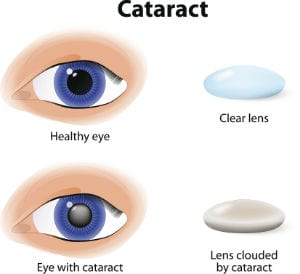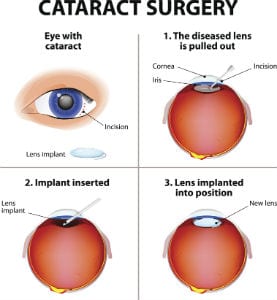A lot of people have questions about cataracts. What is a cataract? What causes a cataract? What are cataract symptoms? How much is cataract surgery? And we have the answers to those questions. We are Florida Eye Specialists and Cataract Institute, after all. Our physicians have performed over 50,000 cataract surgeries to those in the greater Tampa Bay area since 1982. Let us share with you some general information about cataracts to answer questions you may have.
Here’s what’s covered in this article:
- What is a cataract?
- The three types of cataracts and how they affect your eye.
- What causes cataracts?
- What symptoms you should be aware of?
- Cataract surgery options and cost.
What is a cataract?
Most people ask for a cataract definition when they are researching the condition. Simply put, a cataract is a clouding of the eye’s natural lens, which lies behind the cornea, iris and the pupil.

Types of cataracts
There are three different types of cataracts that effect a human eye; a nuclear cataract, cortical cataract and subcapsular cataract.
Nuclear cataract
A nuclear cataract forms deep in the nucleus of the lens and are usually are associated with aging. The cataract is found in the center of the lens so it interferes with your ability to see distant objects. While the cataract is progressing, your reading vision may temporarily improve because as the lens clouds it changes your eye’s ability to focus. This temporary symptom is called “second sight”.
Cortical cataract
A cortical cataract is characterized by white, wedge-like opacities that start in the periphery of the lens and work their way to the center in a spoke-like fashion. This type of cataract occurs in the lens cortex, which is the part of the lens surrounding the central nucleus. As the cataract wedges towards the central core of the eye it blocks light, causing glare, and loss of contrast and depth. Both near and distant vision become slowly impaired over time.
Subcapsular cataract
A subcapsular cataract occurs at the back of the lens. The cataract begins small and progresses rapidly. People with diabetes or those taking high doses of steroid medications have a greater risk of developing a subcapsular cataract. A subcapsular cataract causes blurriness and glare within a short amount of time compared to a nuclear or cortical cataract. Some have reported vision changes within months.
What cause cataract?
The lens inside our eye focuses light onto the retina for clear vision, both up close and far away. The lens is mostly made of water and protein. As we age, the protein collects which clouds an area of the lens. Over time, it may grow larger and cloud more of the lens.
Research has identified several risk factors that may cause cataracts or may be associated with its progression. These include the following:
- UV exposure
- Diabetes
- Hypertension
- Obesity
- Smoking
- Prolonged use of corticosteroid medications
- Statin medicines used to reduce cholesterol
- Previous eye injury, inflammation, or surgery
- Hormone replacement therapy
- Significant alcohol consumption
- Myopia
- Family history
Cataract symptoms
You may not notice some of the early signs of cataracts at first because they may not impair your vision right away. The development of cataracts is usually a gradual progression so it may not interfere with your vision until your mid to late 60s. But there are some cases where individuals develop these symptoms early in life, even some at birth. Regardless of age, here are the most common symptoms from cataracts.
- Blurred vision
- Objects look hazy or dull
- Lighting glares too brightly
- Dull looking colors
- Haloes around lights
- Frequent vision prescription changes
- Poor night vision
Cataract surgery
During cataract surgery, your cloudy lens is removed and replaced with an artificial lens. This is an outpatient procedure at a surgery center usually associated with your ophthalmologist. The most common method is called phacoemulsification (Phaco). Phaco uses smaller incisions to promote faster healing and reduce the risk of complications. There is also laser cataract surgery that some practitioners offer which reduces the need for surgical blades and hand-held tools. Cataract surgery costs vary based on which method is used, but you can expect the cost to be between $650 and $2,000.

Contact Florida Eye Today for A Consultation
Florida Eye Specialists and Cataract Institute has performed over 50,000 cataract surgeries since 1982. If you suffer from a combination of cataract symptoms, trust the cataract experts at Florida Eye with your eye health and schedule your consultation today.



